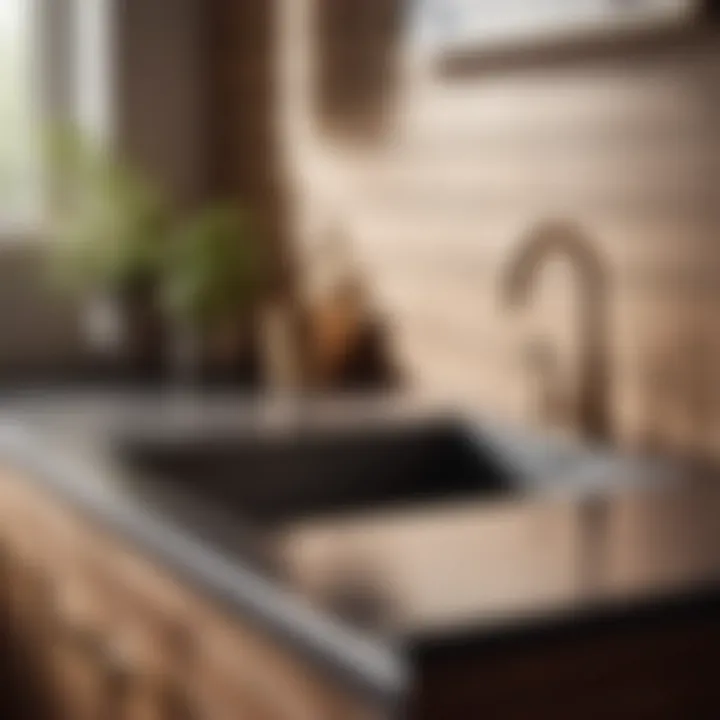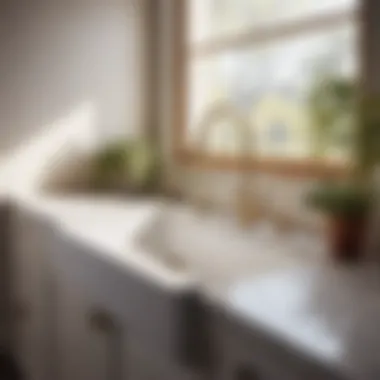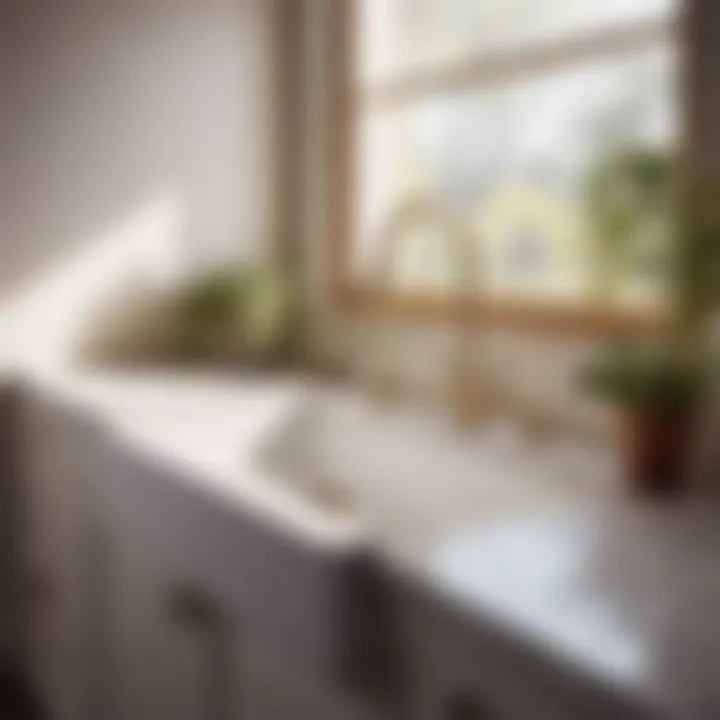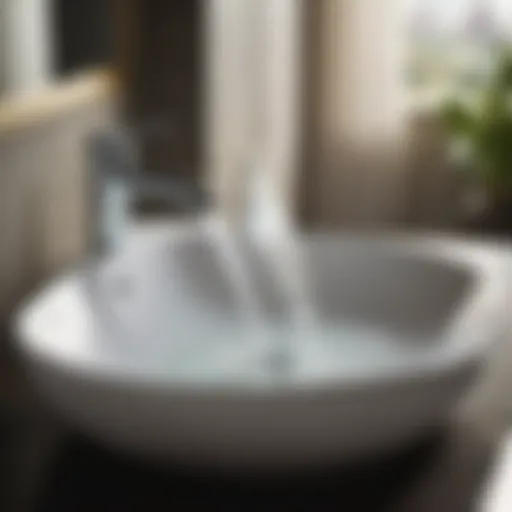Transform Your Laundry Room: The Ultimate Guide to Installing a Sink for Added Convenience


Materials:
- Sink (dimensions: 24" x 18" x 12")
- Faucet with handles (standard size)
- P-trap assembly
- Water supply lines (2x, length: 24")
- Shut-off valves (2x)
- Sink mounting clips (5x)
- Silicone sealant
- Adjustable wrench
- Channel-type pliers
- Pipe cutter
- Screwdriver
DIY Steps:
- Prepare the Area: Ensure the space for the sink and access to plumbing.
- Install Faucet: Attach the faucet according to manufacturer instructions.
- Cut Holes: Cut holes in countertop for sink and faucet installation.
- Mount the Sink: Secure the sink using mounting clips and apply silicone sealant.
- Connect Plumbing: Install P-trap, water supply lines, and shut-off valves.
- Test for Leaks: Turn on water to check for leaks and make adjustments if needed.
Technical Aspects:
- Time Required: 4-6 hours
- Tools: Adjustable wrench, pliers, pipe cutter, screwdriver
- Critical Techniques: Proper sealing and ensuring secure connections for leak prevention
DIY Project Process:
- Start by clearing the workspace and assembling all materials and tools.
- Follow manufacturer guidelines for faucet and sink installation.
- Double-check measurements and alignment before finalizing placements.
Troubleshooting Tips:
- If leaks occur, tighten connections and reapply sealant.
- Ensure proper alignment of faucet and sink for functionality.
- Seek professional assistance for complex plumbing issues.
Introduction
In the realm of home improvement, transforming a laundry room with the addition of a sink can be a game-changer for both functionality and convenience. This segment serves as the gateway to exploring how integrating a sink can elevate the overall utility of this essential space within your home. Imagine the seamless workflow that awaits you as you delve into the process step by step, from initial planning to enjoying the finalized results.
This article is a guiding light for those seeking to revolutionize their laundry room experience. By understanding the importance of meticulously selecting the right sink type, material, and size, readers will embark on a journey towards enhanced efficiency. We explore key considerations, delve into installation intricacies, and provide invaluable maintenance tips to ensure your laundry room becomes a place of ease and productivity.


Embark on a journey with us as we dive into the dynamic world of laundry room enhancements – where a seemingly simple addition can create a ripple effect of convenience and practicality throughout your living space.
Initial Planning
When considering the enhancement of your laundry room by installing a sink, the initial planning phase is crucial to ensure a successful and efficient outcome. It sets the foundation for the entire project, guiding you through key decisions that will impact the functionality and aesthetics of your space. Initial Planning involves assessing various factors like space availability, plumbing requirements, and aesthetic preferences to determine the best approach for integrating a sink into your laundry area. By carefully planning and strategizing at this stage, you can avoid unnecessary setbacks and optimize the convenience and practicality of your laundry room.
Assessing Space Availability
In the realm of Assessing Space Availability, the significance lies in understanding the dimensions and layout of your laundry room to accommodate a sink seamlessly. Measurements and Layout play a pivotal role in this process, as they dictate the feasibility of incorporating a sink without overcrowding the space. When analyzing the space available, it's essential to consider the existing infrastructure, such as water connections and drainage systems, to ensure a smooth integration of the sink. A well-thought-out layout not only enhances the visual appeal of the room but also facilitates ergonomic functionality, making laundry tasks more convenient and efficient. Precision in measurements is key to optimizing the utilization of space and creating a harmonious balance between the sink and other essential elements in the room.
Determining Sink Type
Determining Sink Type involves choosing between a Utility Sink and a Standalone Sink, each offering distinct advantages based on your specific needs and preferences. A Utility Sink is typically more robust and utilitarian, ideal for heavy-duty tasks like handwashing clothes or cleaning supplies. On the other hand, a Standalone Sink provides a more aesthetic appeal, often resembling traditional kitchen sinks and blending seamlessly with the overall decor of the laundry room. Understanding the unique features and benefits of each sink type enables you to make an informed decision that aligns with your usage patterns and design aesthetic. Consider factors such as durability, maintenance, and visual cohesiveness with the existing interior to select the most suitable sink type that enhances both functionality and style in your laundry room.
Choosing the Right Sink
In the process of enhancing your laundry room by installing a sink, one of the key decisions you'll need to make is choosing the right sink. This choice is crucial as it can significantly impact the functionality and aesthetics of your laundry space. By selecting the appropriate sink, you can improve workflow efficiency and overall satisfaction with your laundry room.
Material Selection
When it comes to material selection for your sink, options like stainless steel, porcelain, and composite materials offer various benefits and considerations.
Stainless Steel, Porcelain, Composite
Stainless steel sinks are known for their durability and resistance to stains and heat. They provide a sleek, modern look that complements contemporary laundry room designs. Porcelain sinks, on the other hand, bring a classic, elegant touch to the space and are easy to clean. Composite sinks offer a blend of durability and aesthetic appeal, with options available in a wide range of colors to match your decor.
Each material has its unique features. Stainless steel is non-porous, making it resistant to bacteria growth, while porcelain provides a timeless charm that can elevate the overall appearance of your laundry area. Composites offer a good balance of durability and style, allowing you to customize your sink to suit your preferences.


Considering these factors, the choice of material should align with your priorities such as maintenance ease, aesthetic preferences, and budget flexibility, ensuring a suitable fit for your laundry room renovation project.
Installation Process
In the realm of enhancing your laundry room by adding a sink, the installation process plays a pivotal role. It sets the foundation for the convenience and functionality you aim to achieve. Understanding the ins and outs of the installation process ensures a seamless integration of the sink into your space. From plumbing considerations to mounting the sink, each step is crucial in creating a well-designed and efficient laundry area.
Plumbing Considerations
Connecting to Water Supply
When it comes to connecting your sink to the water supply, precision and expertise are key. The connection to the water supply is a fundamental aspect of the installation process. It involves ensuring a proper and secure link between the water source and the sink, allowing for seamless water flow during laundry activities. Opting for high-quality materials and proper fittings is essential to prevent leaks and maintain a reliable water supply to the sink. The connection to the water supply is a popular choice due to its reliability and convenience, providing easy access to water for various laundry tasks.
Drainage System
The drainage system in sink installation is equally significant as connecting to the water supply. Proper drainage ensures effective water disposal, preventing water buildup and potential damage to your laundry room. An efficient drainage system incorporates adequate slope for water flow, correct placement of pipes, and proper connection to sewer lines. Choosing quality materials for the drainage system minimizes the risk of clogs and ensures smooth water drainage. While the drainage system is crucial for maintaining a clean and functional laundry space, regular inspections and upkeep are vital to prevent potential plumbing issues.
Mounting the Sink
Wall-Mounted vs. Freestanding
When considering how to mount your sink, the choice between wall-mounted and freestanding options impacts both functionality and aesthetics. Wall-mounted sinks offer a space-saving solution, ideal for smaller laundry rooms where floor space is limited. They provide a modern and sleek look, elevating the overall design of the space. On the other hand, freestanding sinks offer more versatility in placement and can create a focal point in larger laundry rooms. Their standalone design allows for flexibility in layout and design choices. Each option comes with its advantages and disadvantages, so selecting the most suitable mounting style depends on your specific preferences and spatial requirements.
Adding Functionality
When it comes to enhancing your laundry room, adding functionality is key to maximizing efficiency and convenience in your day-to-day tasks. By incorporating smart storage solutions and optimizing your workspace, you can transform your laundry area into a well-organized and highly functional space that caters to your specific needs. This section will delve into the importance of adding functionality to your laundry room, focusing on elements such as storage solutions and workspace optimization.
Incorporating Storage Solutions


Cabinets, Shelves, and Hooks
In the realm of laundry room functionality, cabinets, shelves, and hooks play a crucial role in keeping your space organized and clutter-free. Cabinets offer ample storage for detergents, fabric softeners, and other laundry essentials, while shelves provide a convenient spot for folding clothes or storing baskets. Hooks offer a practical solution for hanging delicates to dry or keeping frequently used items within reach. The versatility of cabinets, shelves, and hooks make them popular choices for enhancing functionality in laundry rooms, allowing for efficient organization and easy access to commonly used items.
Cabinets, shelves, and hooks are known for their space-saving qualities, making them invaluable additions to streamline your laundry routine. Their ability to maximize vertical storage space and keep surfaces clear contributes to a more organized and visually appealing laundry room. While cabinets offer enclosed storage to keep items out of sight, shelves provide open storage for quick access to frequently used items. Hooks, on the other hand, offer a flexible storage solution that can accommodate a variety of items without taking up precious floor space.
Enhancing Workspace
Countertop Installation
A significant aspect of adding functionality to your laundry room is countertop installation. Countertops provide a dedicated workspace for sorting, folding, and ironing clothes, transforming your laundry room into a multi-functional area. With a durable and easy-to-clean surface, countertops offer a practical solution for handling various laundry tasks with ease.
Countertop installation is a popular choice for laundry rooms aiming to increase workspace efficiency. The key characteristic of countertops lies in their ability to provide a smooth and flat surface for organizing laundry items and working on tasks comfortably. By installing a countertop, you can elevate the functionality of your laundry room by creating a designated space for various activities, from sorting and folding to organizing supplies.
Countertops offer advantages such as a stable work surface for handling laundry tasks, reducing clutter by providing a designated area for different activities, and enhancing the overall aesthetic appeal of the laundry room. However, it's important to consider the size and layout of your laundry room when installing a countertop to ensure optimal functionality and efficiency in your laundry routine.
Maintenance Tips
When it comes to enhancing your laundry room by installing a sink for added convenience, paying attention to maintenance tips is crucial. Proper maintenance ensures that your sink and surrounding area remain in optimal condition, helping you get the most out of your laundry space. By incorporating regular maintenance tasks into your routine, you can prevent costly repairs and maintain a functional and efficient laundry area.
Cleaning and Care
In the realm of maintenance tips for your laundry room sink, focusing on cleaning and care is key. Ensuring that your sink is clean not only contributes to its aesthetics but also plays a significant role in preventing clogs and stains. Regular cleaning helps eliminate soap scum, grime, and debris that can accumulate over time, leading to potential blockages in the drainage system.
Avoiding Clogs and Stains
One specific aspect that deserves attention when it comes to cleaning and care is avoiding clogs and stains. By using gentle yet effective cleaning agents and tools, you can maintain a clear pathway for water to flow smoothly down the drain. Additionally, being mindful of what goes down the sink can help prevent unwanted stains and buildup.
Leak Detection and Repairs
Another essential element of maintenance for your laundry room sink is regular inspections for leak detection and necessary repairs. Proactively checking for leaks can save you from water damage and costly repairs in the future. Identifying and addressing leaks promptly can preserve the integrity of your sink and plumbing system, ensuring that your laundry room remains a functional and well-maintained space.
Overall, prioritizing maintenance tips such as cleaning, avoiding clogs and stains, and conducting regular inspections for leak detection and repairs is fundamental in maximizing the utility and longevity of your laundry room sink. By following these guidelines, you can enjoy a hassle-free laundry experience and prolong the lifespan of your sink investment.







